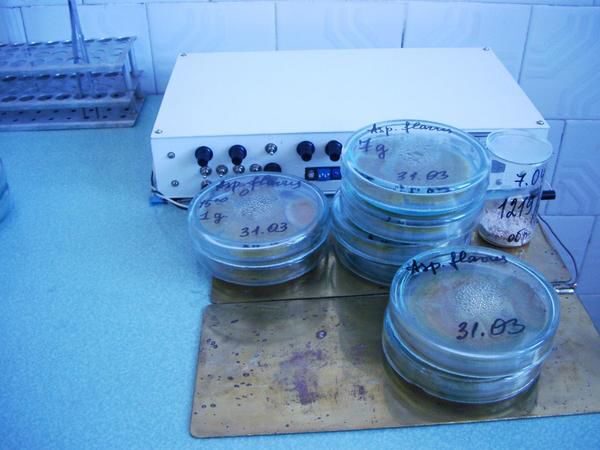Fungistatic effect of the device "LAD". The influence of the device at the LAD cultural-morphological properties of the mold fungus Aspergillus flavus
Aspergillus flavus is common mycobiota of crops and feed in storage. If you violate the conditions of storage, for example, with an increase in humidity, temperature, spores of the fungus are actively developed, using the nutrients of the substrate, thereby reducing the nutritional value of grain and highlighting throughout its life water, gas and mycotoxin-metabolites of fungi that have toxic properties for living organisms.
Currently scientists are searching for methods of slowing or complete inactivation of spores, which do not influence on the nutritional value of food and indifferent to living organisms.
The purpose of the study (search for plant protection products)
Studying the effect of weak broadband electromagnetic fields with amplitude-phase modulated information on the development of colonies of Aspergillus flavus of different ages .
The experimental plan
Cultures of different ages (in Petri dishes) on agar Czapek were constantly influenced by the device’s radiation for 10 days.
Groups of cultures of all ages are placed in 2 cups, which were kept constantly in the field of exposure, and 2 cups of control, not exposed to the device.
1. inoculated with a cup without visible growth (age - 2 hours)
2. 2-day culture.
3. 6-day culture
4. 8-day culture
5. control - inoculated simultaneously with the first group.
The observation
The observation was carried out, starting from the second day of the beginning of exposure.
On the 2 nd day in cups of the group 1 no visible growth in the control-sterile colony, mycelium white, konidiogennye swellings are absent, D = 4mm .* (11,4%)
On the 3rd day 1 group has a sterile mycelium white, D = 3mm (8.5%) control-the emergence of Conidial heads with sterigmata, located in 1 layer, D = 13mm (37.1%);
Group 2 corresponds to the development of the control.
On 5 th day: 1 group D = 20mm (57,1%), white to yellow concentric rings Conidial zones, sterigmata 1-2x tiers, the growing edge of poorly articulated thin. Active sporification it.
Control-colony D = 31 mm (88,5%), intense yellow color in the center gets a green tint, sterigmata stacked, fialidy form long chains of conidia. Active sporification.
Group 2 D = 30 mm (85,7%), yellow, moderate sporification.
10 th day. 1 group D = 27mm (77.1%), white mycelium zone alternate with yellow bands formation of conidia, sterigmata 1.2 tiers, chains of conidia are short. The edge of the colony weakly expressed.
Control - the colony of green, active sporulation, long chains of conidia formed columns. D = 35 mm. (100%)
Groups 3 and 4 have a colony of yellow-green hues, D = 33-35mm, (94,2% - 100%), increased formation of conidia.
Conclusions:
The most significant difference in the development of colonies was observed in the group 1 compared with the control, 10 days lagging in size was 22.9%, while in other groups, the maximum difference was 5.8% So fungistasis of the regime "LAD 03" for germinating conidia Asp. flavus, cultured on Czapek agar is identified.
A *- the average diameter of the colony.
Resulting fungistasis of the device "LAD" documented in the photographs.


|
